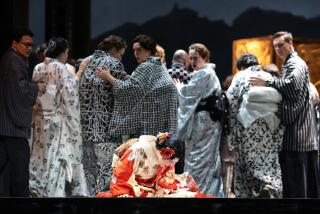BALLET THEATRE AT SHRINE : VAN HAMEL REFOCUSES ‘THE SLEEPING BEAUTY’
- Share via
Youth is always wasted on the young.
When American Ballet Theatre introduced Sir Kenneth MacMillan’s murky-kitschy production of “The Sleeping Beauty” to Los Angeles on Tuesday, the central tutu was entrusted to a very promising, very deft, very vapid dancer just promoted from the rank and file.
She certainly looked the part of the rapturous 16-year-old princess. But she didn’t exactly fill it.
Wednesday, it was the turn of a bona fide, authoritative, mature, stylish ballerina. The difference was staggering.
Although the calendar may not call Martine van Hamel a teen-ager, that is an irrelevant technicality. At 41, she is just old enough to know something about the ecstasy, the insecurity, the yearning, the mercurial ardor and the vulnerability of adolescence.
Even more important, she knows how to focus and project these fragile qualities, even in the wide, drab, open--and two-thirds empty--spaces of Shrine Auditorium.
In a company dominated by eager neophytes and optimistic debutantes, Van Hamel has become a lonely throwback to a time when important dancers had to be magnetic, not just pretty.
Ironically, in the best of all possible balletic worlds she might not be an ideal candidate for the delicate duties of Aurora. Uncommonly tall and statuesque, strong and intrinsically grand, she would seem predestined by nature to portray the formidably ethereal Lilac Fairy, and indeed has done so with rare distinction.
Still, the glamorous attitudes of the titular ingenue have always exerted their irresistible appeal. Just as every Myrtha wants to be Giselle, every Lilac Fairy wants to be a Sleeping Beauty.
By dint of intelligence, imagination, sensitivity, taste and sheer willpower, Van Hamel triumphs over what some might perceive as anti-type casting.
Wednesday night she swept through the Rose Adagio with girlish urgency and exuberance, the intensity of which made the time-freezing balances all the more startling. She introduced a telling, contrasting veil of detachment in the vision scene, only to bathe the climactic pas de deux in heroic rapture.
She did tend on this occasion to reduce dramatic portraiture to generalities--a manner systematically adopted by just about everyone in this production. Nevertheless, she constantly used her supple arms, her commanding line, her discerning attack and innate sense of the lyrical phrase to make specific, illuminating comments on character.
Dance, for its own abstract sake, was never an issue here.
The current Ballet Theatre roster does not seem to command a really worthy cavalier for a ballerina of Van Hamel’s stature. Young Robert Hill did his valiant best, however, to hold his own in such exalted company. He danced with informed suavity, with taut strength and a somewhat dour aura of aristocratic boredom.
Clark Tippet, who in other seasons had been Van Hamel’s Prince Charming, provided exceptionally sympathetic support as her principal partner in the Rose Adagio. Other newcomers to the cast included Carla Stallings as a tall, tough, superficially involved Lilac Fairy; Michael Owen as a femme fatale Carabosse even less aggressive than his predecessor, and Julio Bocca as a rough but flamboyant Bluebird. Switching roles with Bocca, Johan Renvall nearly managed to make elegant coherence of the new Gold variation.
In the well-staffed pit, Stewart Kershaw served Tchaikovsky with a bit more elan than had the opening-night conductor. Everything is relative.
The Ballet Theatre management, incidentally, is treating its audience with something remarkably akin to smug cynicism this year as regarding casting announcements.
Five performances of a new production of “Giselle” loom two weeks away, yet no one seems to know who will be dancing and when. The public is being asked to lay out as much as $42 for a ticket to a mystery product. Perhaps this is Mikhail Baryshnikov’s idea of Russian roulette.
One wonders whether such disregard for aesthetic priorities and good business practices can explain the strikingly low attendance figures.
More to Read
The biggest entertainment stories
Get our big stories about Hollywood, film, television, music, arts, culture and more right in your inbox as soon as they publish.
You may occasionally receive promotional content from the Los Angeles Times.










